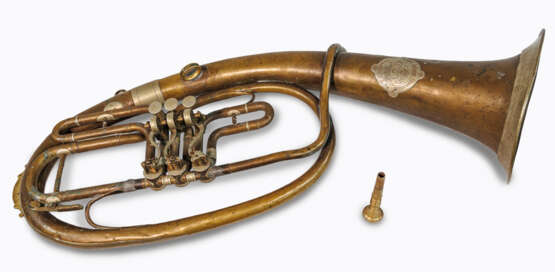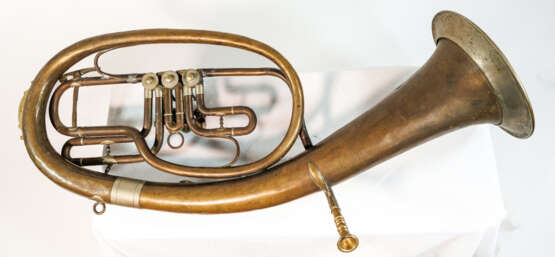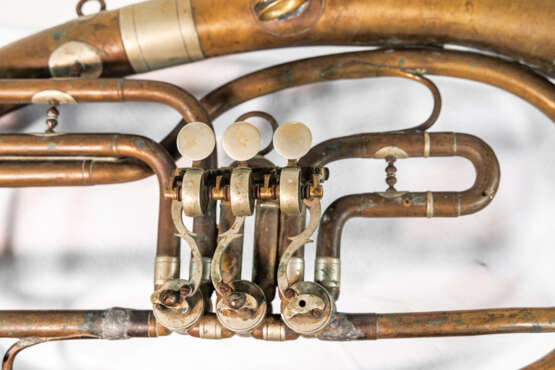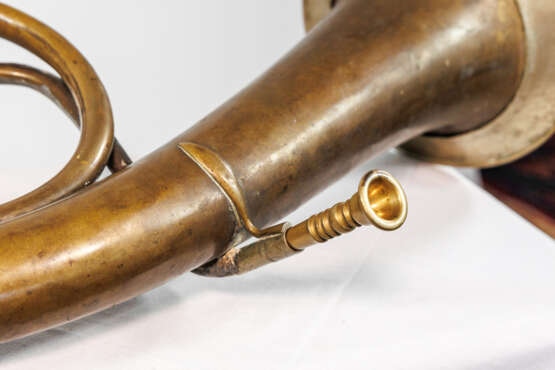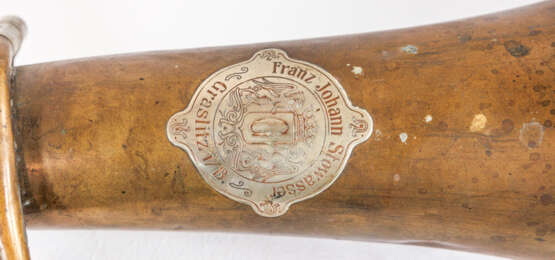ID 909808
Lot 61 | TENORHORN / BARITONE IN B, FRANZ JOHANN STOWASSER, GRASLITZ 19. JH.
Estimate value
€ 40 – 80
Das Tenorhorn, auch als Baritone bezeichnet wurde von Franz Johann Stowasser in Graslitz, Böhmen, dem heutigen Tschechien gebaut. Die Instrumentenbauerfamilie Stowasser stammt aus Graslitz (Kraslice/CZ) und ist von dort aus weit verzweigt. Ein Familienmitglied ging nach Budapest/Ungarn. Die Familie ist auch in Wien nachweisbar.
Ein Tenorhorn wird mit einem Bechermundstück (ein tiefes Kesselmundstück) gespielt und gehört zu den Bügelhörnern. Am Instrument findet sich ein nicht originales Hornmundstück. Es erklingt ein B≈124 Hz, was einem Kammerton von a1≈468 Hz entspricht.
Das Instrument besitzt drei Ventile, die jeweils mit „6“ gepunzt sind. Im Becher befindet sich eine fein ziselierte Gravur.
Abmessungen: Länge: 79,5cm; Durchmesser des Schalltrichters: 21,5cm.
TENOR HORN / BARITONE IN B, FRANZ JOHANN STOWASSER, GRASLITZ 19TH CENTURY.
The tenor horn, also called baritone, was built by Franz Johann Stowasser in Graslitz, Bohemia, today's Czech Republic. The Stowasser family of instrument makers originated in Graslitz (Kraslice/CZ) and branched out in different directions. One family member went to Budapest/Hungary. There is also evidence of the family in Vienna.
A tenor horn played with a cup mouthpiece (a deep cup mouthpiece) and belongs to the “bulges”. The horn mouthpiece is not original to the instrument. It sounds a B≈124 Hz, which corresponds to a concert pitch of a1≈468 Hz.
The instrument has three valves which are stamped "6" each. There is a finely chiseled engraving in the cup.
Dimensions: Length: 79.5cm, bell diameter: 21.5cm.
| Auction house category: | Musical instruments and accessories |
|---|
| Auction house category: | Musical instruments and accessories |
|---|
| Address of auction |
Galerie Moenius AG Kirchstraße 1 56653 Wassenach Germany | |
|---|---|---|
| Preview |
| |
| Phone | +4915782646146 | |
| Conditions of purchase | Conditions of purchase | |
| Shipping |
Postal service Courier service pickup by yourself | |
| Payment methods |
Wire Transfer |
